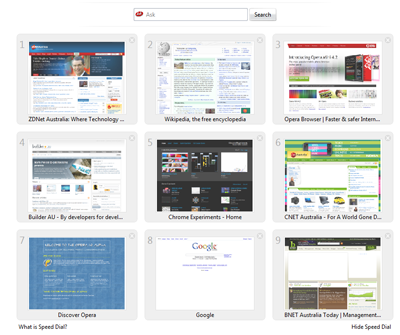Browsers' creativity sparked by new tab

A rash of creativity has overcome browser vendors recently in a completely unexpected place: the content of the new tab page.
Gone are the days of seeing an unobtrusive blank page and blinking cursor in the address bar by default on opening a new tab in the browser. Nowadays it's all about in-your-face helpfulness wrapped up in glitzy attire.
The first browser to dress up the new tab presentation was Opera with its Speed Dial feature.

Speed Dial: you're the inspiration. (Screenshot by Chris Duckett/ZDNet.com.au)
However, Speed Dial now looks quite spartan in relation to its contemporaries and the pages that appear within it must be selected by the user. Changing the size of the grid can be done via an .ini file.
It wasn't until Google released its Chrome browser that things really took off.
Google Chrome's new tab page, it's Speed Dial++. (Screenshot by Robert Vamosi/News.com)
The inner cynic likes to point out that what Google did here was take Speed Dial, hand the site selection criterion to a most visited algorithm and slapped a recent bookmarks list on the right. But it worked.
Google made the process and presentation automated and dead easy to use instead of needing to take the time to customise, hence the nerdgasm when Chrome appeared.
Safari goes for style over substance. (Credit: Apple)
The next browser to make over its new tab page was Safari. Safari takes the best features of Opera and Google's approach, adds in a dynamic most visited algorithm with the option to pin a site, and focuses on the site thumbnails by covering it all in some typical Apple glitz.
In my experience with Safari, one drawback that I have seen in this approach is that the site thumbnails reflect the current content of the site and even log-in to them — meaning that it will show the contents of your Gmail inbox, not log-in form — which can lead to some delay in showing the thumbnails.
IE8 distances itself from its rivals. (Credit: Microsoft)
Enter Internet Explorer, and finally we have a different approach to the others. When IE8's second beta appeared, a nice blog post detailed the design choices that Microsoft went through.
From the blog post: "We could have added a search box to the new tab page [...] However, IE's search box is already visible and available to the user [...] so adding yet another redundant search entry point was uninteresting".
This makes good sense and I wish that it was something that Opera would do; two search boxes within a few pixels makes little sense. Microsoft chose to not develop a quick way to visit bookmarks or regularly viewed pages as it was considered duplicative.
An idea for new tabs in Mozilla Labs. (Screenshot by Chris Duckett/ZDNet.com.au)
Lastly we come to Firefox, which is the only major browser to retain a blank page when opening a new tab, but for how long? Discussion has been brewing in Mozilla Labs over what to do. They too subscribe to the less glitz is more mantra that the IE team used.
One nice improvement that Mozilla's "New Tab" team has done is to incorporate the latest items in a site's RSS feed under the site's homepage. This is a very useful way of getting directly to the content for news and blog sites.
The current set-up is by no means set in stone; if you are a Firefox user and wish to give feedback, then get involved.
Wash-up
It's good to see each browser trying out new things and not having to get bogged down in a standard vs. non-standard battle for once. While it is easy to point the finger and say that X is copying Y's implementation, the fact is that industry players have always taken the best features of the competition and used them to improve its own product.
It will be interesting to see what the Firefox team comes up with and how they use the knowledge of those that have gone before them. Note that while I was writing this article, the new tab plug-in updated for a second time today; you cannot fault Mozilla for not trying.